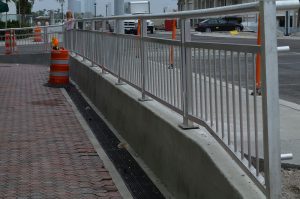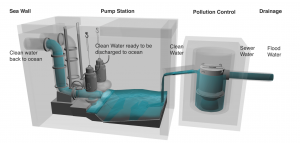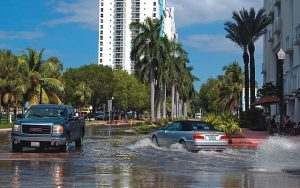Posted April 29, 2016
By KATE HOVAN
Paige Fairman, a Miami local and University of Miami student, recalls the time before her Miami Beach home was rebuilt. According to Fairman, every time it rained, her home’s driveway would flood and, though her own home’s problems may be solved today, she knows the issue has not disappeared for the rest of the city.
Unfortunately, Fairman’s words are not an exaggeration. Researchers have confirmed that sea level rise will eventually overcome the Southeast Florida area and it’s likely to happen sooner rather than later. While sea level rise in general has long been a complication of climate change, the rate at which the sea levels are rising is accelerating, causing new alarm for Southeast Florida and the world.
It is estimated that seas could rise anywhere from 20 inches to three feet by 2100, according to a 2010 report by the Florida Oceans and Coastal Council (FOCC) in Tallahassee. The FOCC is a state government research group within the Florida Department of Environmental Protection. The report notes that there is no longer a question about whether sea levels are rising, but instead, how significantly it will rise.
Even more problems are arising given the fact that Southeast Florida sits atop porous limestone, meaning rising seas are slowly submerging the area both through underground infiltration as well as at the shorelines. Fresh drinking water will also be affected if the water keeps rising from below.
For now, the city of Miami has employed techniques like elevated sidewalks, elevated roadways, sea walls and pumps to offset flooding. These solutions are only temporary, however, and are unlikely to hold up against a more significant sea level rise in the coming decades.

An elevated sidewalk in Miami, one of the many ways the city is coping with constant flooding. (Wikimedia Commons)
Benjamin Kirtman is a professor at the University of Miami’s Rosenstiel School of Marine and Atmospheric Science (RSMAS) and the director of the Center for Computational Science Climate and Environmental Hazards program.
Kirtman explained that flooding issues with sea level rise today are becoming more of a problem and the region must keep moving forward with long-term planning.
“Policy regarding sea level rise is constantly changing in South Florida. This is due to the fact that we are seeing more and more ‘clear sky flooding.’ Eventually, the state and federal government will also have to participate in the policy solutions,” Kirtman said.
In accordance with current flooding and future problems, the greater South Florida area and its universities are faced with a new urgency about how to deal with sea level rise.
Both the University of Miami’s Rosenstiel School of Marine and Atmospheric Science, located on Virginia Key, and Florida International University’s Biscayne Bay campus are at risk for sea level rise and community members of both universities are stressing the importance of raising awareness.
Gina Maranto, a former journalist and current professor and undergraduate program director of ecosystem science and policy at UM, devotes much of her work and writing to climate change. She explained that sea level rise cannot be stopped altogether, and mitigation is no longer the world’s best option in dealing with climate change and sea level rise.
“What most of us are looking at now is adaptation,” said Maranto.
Maranto added that engineers have even contemplated making Miami the “new Venice,” building specially designed canals for transportation.
More realistic than canals, however, Maranto said that adaptation could simply mean new policies for future construction.
“Adaptation could be demanding that all new residences be built on stilts or designing for high ground,” she added. This is extremely important for Miami, where waterfront property is highly coveted.
Teddy Lhoutellier, also one of UM’s experts on environmental issues and policy, is the sustainability manager for Green U, a program aimed at increasing sustainability and teaching people to be conscious of their roles as keepers of the environment.
Lhoutellier also agreed that coastal policy must change in order for Southeast Florida to survive sea level rise, and long-term strategies need to be developed as quickly as possible.
Lhoutellier said that Green U has collaborated with many other organizations to find solutions to the problem. In 2014, the program attended the annual Southeast Florida Regional Climate Compact and represented UM among many other universities and local organizations.
On a smaller scale, Yiran Zhu, a UM alumna and current multimedia graphic designer for the Sun Sentinel in Fort Lauderdale, also attempted to raise awareness about sea level rise in a very unique way.
Zhu created a capstone project about sea level rise while completing her master’s degree at UM. The online project, called City Up High, features Zhu’s own graphic designs that help people visualize sea level rise and Miami’s adaptation methods.

A graphic design demonstrating how Miami’s pump stations work to reduce flooding. (Courtesy of Yiran Zhu, City Up High)
Zhu wanted to use her designs to shed light on all the techniques being used to cope with sea level rise at the moment. She hopes people will give their own input or ideas upon seeing her designs.
“I took a more technical focus on my project by specifically visualizing the geographic reason and breaking down each solution that Miami Beach has taken or will take, because I wanted to be completely transparent about this issue,” she explained.
“I hope whoever sees my work can learn something from it,” Zhu added. “The best result would be they learn the fact that it’s happening, they start thinking about what they can do to help and they appreciate people who have been working on this.”
Florida International University is also doing its part to help fight climate change and adapt to sea level rise. The university even has its very own Sea Level Solutions Center (SLSC), which was launched in the summer of 2015.
The SLSC works by bringing together different FIU faculty members and using interdisciplinary collaboration to protect South Florida from sea level rise.
The center’s communications coordinator, Bradley Schonhoff, said the SLSC is looking at the bigger picture to deal with climate change and sea level rise.
“We are working to plan and develop long-term resiliency strategies for the region overall,” said Schonhoff.
The SLSC, like Green U, has also worked with several state organizations, including the Southeast Florida Regional Climate Compact and the Federal Emergency Management Agency (FEMA).
“Most of our work has begun more locally, but we are nevertheless working to inform the state and federal government of the science behind sea level rise, and its implications for vulnerable, coastal areas,” Schonhoff explained.
The SLSC also employs student interns, but the center hopes to get even more people involved in sea level rise efforts.
“Education and outreach are especially important in creating change and building resiliency to sea level rise here in South Florida,” said Schonhoff. “So we are also taking every opportunity to attend other events and activities outside of FIU.”
In addition to universities, independent organizations are also doing their part to save the area from rising seas, pairing with state and local governments to accomplish their goals.
The Miami Waterkeeper (MWK) is a non-profit organization with a focus in promoting and maintaining clean water in South Florida and Biscayne Bay. The MWK is also very involved with issues of sea level rise, as well.
In addition to protecting Biscayne Bay, Jessica Bolson, who is the MWK’s director of climate and freshwater programs, said the organization works by informing the community as best it can about sea level rise and clean water.
“We are also very well informed on local and regional scale action in regard to sea level rise and network with local climate leaders to understand their plans and needs for action,” Bolson explained. “All of this is to pursue our mission goal of seeing that the best available climate science inform the decision making.”
The executive director of the MWK, Rachel Silverstein, also emphasized the importance of educating the people who have the power to implement new policy in South Florida.
“We educate the public and elected officials about the science behind sea level rise and advocate for solutions to the sea level rise issue,” Silverstein said.
“There still isn’t a silver bullet to address sea level rise and many still don’t acknowledge that it’s a threat for South Florida. The solutions that do exist are often very expensive, too,” Silverstein added. “We’re working on public education to build support for finding solutions and supporting green infrastructure projects.”
Though it may seem that universities and organizations in Southeast Florida are collectively raising awareness about sea level rise, looking towards the future still stirs up apprehension for some experts.
“We can point to some pretty strong evidence that by 2100 we’re going to have quite a large rise in sea level,” Maranto said. “I think the problem at that point is much larger than UM. It’s the whole world.”
Lhoutellier also agreed that much more must be done if Southeast Florida is to survive sea level rise.
“Clearly we are positioning ourselves as a community affected by sea level rise, and we’re really behind on alternatives for transportation and energy,” Lhoutellier added. “We have to be resilient.”
According to experts, education and implementation are equally as important in dealing with climate change and its effects, like sea level rise. Without informing people about the reality of sea level rise, the people of Southeast Florida are unlikely to make the changes necessary to stay afloat.

